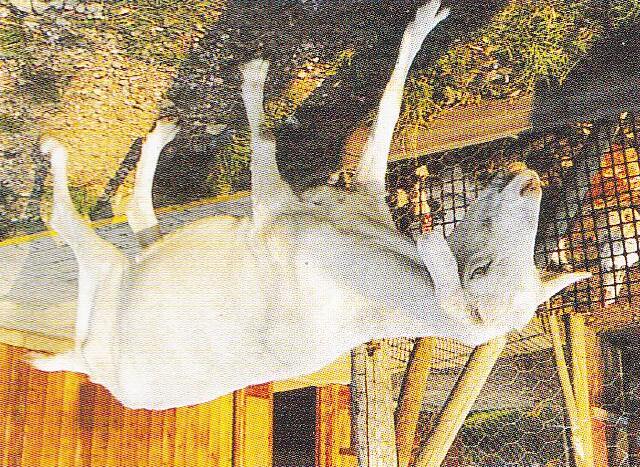
2 minute read
1996 1996 1996 1996 1996
The Lovely Tinkerbell...
We were saddened whenTinkerbell,a cow we had rescued from the dairy industry when she was due to be slaughtered for meat,was diagnosed by three independent vets as having B.S.E.-‘mad cow disease’. Had we not saved her,she would have been eaten by the public while incubating this terrible disease. It was heart-rending to see the distress caused to Tinkerbell by this condition, which came on very quickly. She was humanely and peacefully put to sleep. Tinkerbell was a beautiful and gentle creature and was greatly missed by all who knew her, especially Pixie, whom she had mothered as a week old calf after he was heartlessly taken away from his real mother while she was in the dairy industry. Her milk was then taken for humans to drink instead of nourishing Pixie. Dear Pixie went on to enjoy life in the Sanctuary until he was sixteen years old.


Gerald the Goat...
was brought to Hillside in an emaciated condition. He had been left tethered without food or water and so was badly dehydrated and had sores on his neck.
Gerald was also suffering from a skin disorder, gastroenteritis, worms, lice and had maggots living on faeces stuck to his hind quarters! Thankfully his owner was prosecuted for neglecting him and causing him so much suffering.
200 Rescued animals...
La Vizelle...
LaVizellewithMidnightsoon aftertheywere rescued
Having names such as Queen of Erin, Distinctly Northern and Mill Reef in her parentage didn’t help La Vizelle when she was found to be just seconds too slow on the race track. She was cruelly dumped into a horse market at just two years old and, like thousands of others, would certainly have been consigned to the slaughterhouse had Hillside not stepped in to save her and another failed racehorse we called Midnight. In 1997 La Vizelle became one of the animals supporters can ‘adopt’ to receive twice-yearly letters and photos about her life at the Sanctuary, which helps raise funds to feed and care for LaVizelle and all the other rescued animals at the Sanctuary.
Heartless Shame of Hormone Replacement Therapy...
We had already campaigned to make women and doctors aware of the suffering caused to horses in order to produce certain HRT drugs prescribed to ‘menopausal’ women. The oestrogen in the drugs is obtained from pregnant mares’ urine (PMU). At least 45,000 mares are put in foal every year just to produce urine. We exposed how the mares are tethered in tiny stalls for six months of the year, unable to walk backwards or forwards or even lie down. This causes psychological frustration and all sorts of physical problems, such as oedemas (swelling of the stomach) and swollen legs. Reports told how the mothers-to-be are kept permanently thirsty, their water intake restricted so the urine produced is more concentrated. The main company producing PMU, which is marketed under the trade names Premarin and Prempro, is now Pfizer.


We wanted to find out what happens to the foals. The drug company claimed they were sold to ‘good homes for riding’ but reports showed this to be untrue. There is no market in any country for so many foals, except of course, for the horse meat trade. At one time many foals were killed at birth, like calves in the milk industry, but to placate angry animal lovers, and keep profits soaring, foals were left with their mothers for longer. We travelled to Canada to investigate and attended four foal sales. At each, around 3500 young foals and discarded PMU mares were crammed into pens. They stood in the heat for several hours, most without water. Foals were trying to suckle milk from each other. The numbers were so great that they were sold in lots of six at a time and by the pound weight! All, except a handful, were bought by meat dealers. We rescued four foals.











